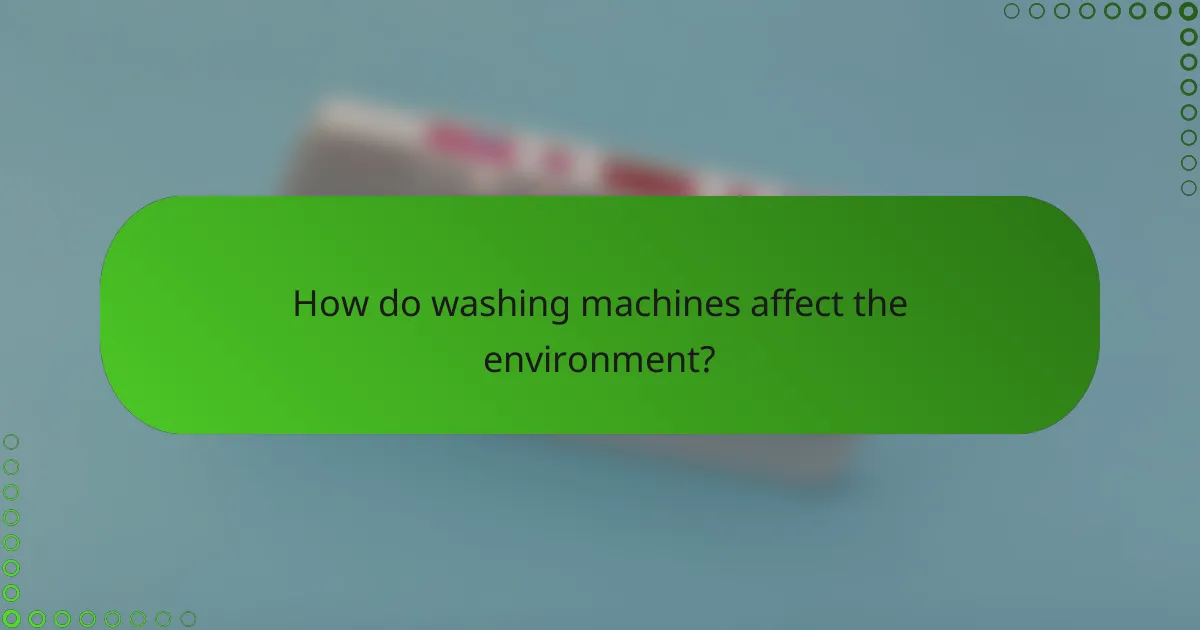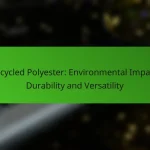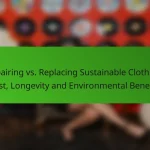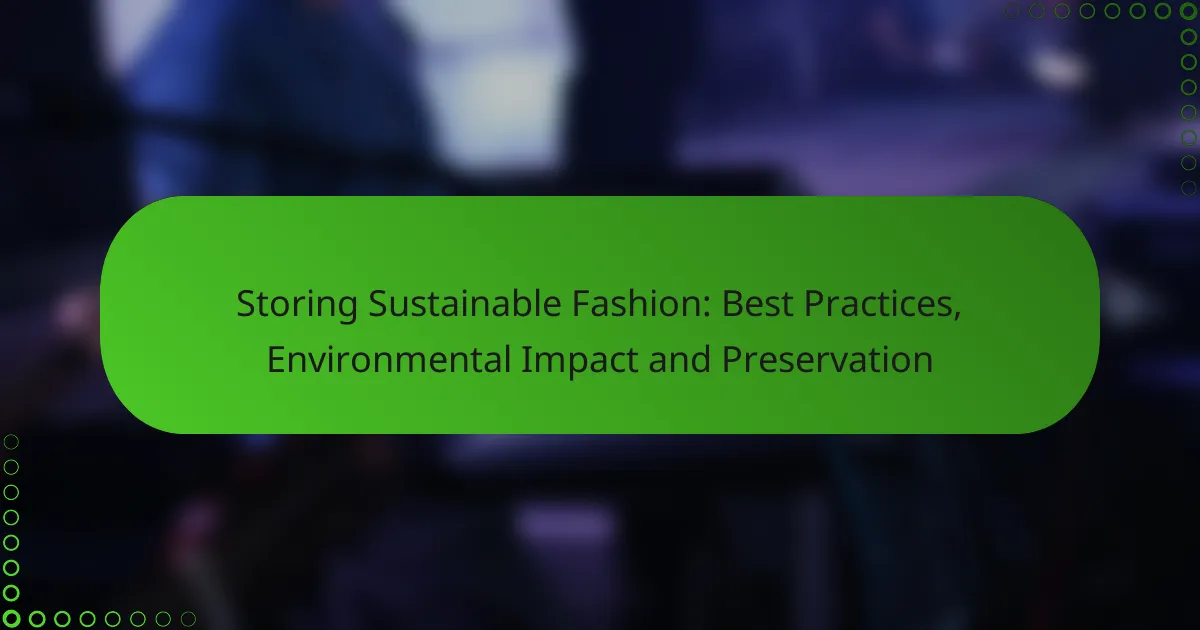Washing clothes is an everyday task that can have a considerable environmental impact due to high water and energy consumption, as well as pollution from detergents and microfibers. By adopting eco-conscious practices, such as using cold water and choosing environmentally friendly detergents, individuals can significantly reduce their laundry’s ecological footprint. Understanding these impacts is crucial for making informed choices that promote sustainability in our daily routines.

How can washing clothes be more eco-friendly?
Washing clothes can be made more eco-friendly by adopting practices that reduce water and energy consumption. Simple changes, such as using cold water and eco-friendly detergents, can significantly lessen the environmental impact of laundry.
Use cold water for washing
Washing clothes in cold water can save a substantial amount of energy since heating water accounts for a large portion of a washing machine’s energy use. Cold water is effective for most everyday laundry, especially with modern detergents designed to work well in lower temperatures.
Consider adjusting your washing habits to use cold water for regular loads. This not only conserves energy but can also help preserve the colors and fabric integrity of your clothes over time.
Choose eco-friendly detergents
Eco-friendly detergents are formulated with biodegradable ingredients that are less harmful to aquatic life and ecosystems. They often contain fewer phosphates and synthetic fragrances, making them a safer choice for both the environment and sensitive skin.
When selecting a detergent, look for certifications such as the EPA’s Safer Choice label or other eco-labels. These indicators can help you identify products that meet specific environmental standards.
Air dry instead of using a dryer
Air drying clothes can significantly reduce energy consumption since dryers use a considerable amount of electricity. By hanging clothes to dry, you not only save energy but also extend the lifespan of your garments by reducing wear and tear.
Consider setting up a drying rack indoors or using a clothesline outdoors. Even in colder climates, air drying can be effective, especially in well-ventilated areas.
Wash full loads to save water
Washing full loads maximizes water efficiency, as washing machines use a similar amount of water regardless of the load size. By waiting to do laundry until you have a full load, you can significantly reduce your overall water usage.
To optimize your washing routine, consider organizing laundry by color and fabric type to ensure you can wash full loads without mixing incompatible items.
Opt for energy-efficient washing machines
Energy-efficient washing machines are designed to use less water and energy compared to standard models. Look for machines with the ENERGY STAR label, which indicates they meet strict efficiency guidelines set by the U.S. Environmental Protection Agency.
Investing in an energy-efficient model can lead to long-term savings on utility bills while also reducing your environmental footprint. If you’re in the market for a new machine, consider features like load-sensing technology that adjusts water levels based on the load size.

What is the environmental impact of washing clothes?
The environmental impact of washing clothes includes significant water consumption, energy use, and pollution from both chemicals and microfibers. Each wash cycle contributes to resource depletion and environmental degradation, making it essential to adopt eco-conscious practices.
Water consumption and pollution
Washing clothes consumes a considerable amount of water, with an average washing machine using around 50 liters per load. This high water usage can strain local water supplies, particularly in areas experiencing drought. Additionally, detergents and fabric softeners often contain harmful chemicals that can pollute waterways when they enter the sewage system.
To mitigate water pollution, consider using eco-friendly detergents that are biodegradable and free from phosphates. Reducing wash frequency and opting for full loads can also help conserve water and minimize environmental impact.
Energy use and carbon footprint
The energy required to wash and dry clothes contributes to a household’s overall carbon footprint. Washing machines typically consume between 0.3 to 2 kWh per load, depending on the model and cycle settings. Using hot water increases energy consumption significantly, leading to higher greenhouse gas emissions.
To lower energy use, wash clothes in cold water whenever possible and choose energy-efficient appliances that meet recognized standards, such as ENERGY STAR in the U.S. Additionally, air-drying clothes instead of using a dryer can further reduce energy consumption.
Microfiber pollution from synthetic fabrics
When washing synthetic fabrics, tiny microfibers are released into the water, contributing to ocean pollution. Research indicates that a single load can shed thousands of microfibers, which can harm marine life and enter the food chain. This issue is particularly concerning as microplastics accumulate in ecosystems.
To combat microfiber pollution, consider washing synthetic garments less frequently and using a microfiber filter bag in your washing machine. Opting for natural fibers, such as cotton or wool, can also help reduce the release of microplastics into the environment.

How do washing machines affect the environment?
Washing machines significantly impact the environment through their energy and water consumption, as well as the emissions associated with their operation. Understanding these effects can help consumers make more eco-conscious choices when selecting and using washing machines.
Energy consumption of different models
The energy consumption of washing machines varies widely depending on the model and its efficiency rating. Generally, Energy Star-rated machines use about 20-30% less energy than standard models, making them a better choice for environmentally conscious consumers. Choosing a high-efficiency model can lead to substantial savings on electricity bills over time.
When comparing machines, look for the annual energy consumption in kilowatt-hours (kWh). A typical washing machine might consume between 100-200 kWh per year, while more efficient models can be below 100 kWh.
Water usage per cycle
Water usage is another critical factor in the environmental impact of washing machines. Traditional top-loading machines can use around 150 liters of water per cycle, whereas high-efficiency front-loading machines typically use about 50-100 liters. Reducing water consumption not only conserves this vital resource but also lowers wastewater production.
To minimize water use, consider washing full loads and using the appropriate cycle settings for the load type. This practice can significantly reduce the overall water footprint of laundry activities.
Impact of older machines vs. newer models
Older washing machines tend to be less efficient in both energy and water usage compared to newer models. Many older machines may not meet current energy efficiency standards, leading to higher operational costs and environmental impact. Upgrading to a modern machine can result in a noticeable reduction in resource consumption.
For example, replacing a 15-year-old washing machine with a new Energy Star model can reduce energy use by up to 50% and water use by about 30%. This change not only benefits the environment but can also lead to significant savings on utility bills over time.

What are the benefits of eco-conscious laundry practices?
Eco-conscious laundry practices offer significant benefits, including cost savings and reduced environmental impact. By adopting these methods, individuals can contribute to a healthier planet while enjoying lower utility bills.
Reduced water and energy bills
Implementing eco-friendly laundry techniques can lead to substantial savings on water and energy costs. For instance, using cold water for washing can reduce energy consumption by up to 90% compared to hot water cycles. Additionally, washing full loads maximizes efficiency, minimizing the number of cycles needed.
Consider investing in energy-efficient appliances, which can further decrease utility expenses. Look for machines with an Energy Star rating, as they typically use less water and energy than standard models.
Less environmental pollution
Eco-conscious laundry practices significantly reduce environmental pollution by minimizing the release of harmful chemicals and excessive water usage. Traditional detergents often contain phosphates and other pollutants that can contaminate waterways, harming aquatic life.
Switching to biodegradable detergents and using natural fabric softeners can mitigate this impact. Additionally, air-drying clothes instead of using a dryer reduces energy consumption and lowers greenhouse gas emissions.
Healthier living environment
Adopting eco-friendly laundry practices contributes to a healthier living environment by reducing exposure to toxic chemicals. Many conventional laundry products contain allergens and irritants that can affect indoor air quality and overall health.
Choosing natural and fragrance-free detergents can help create a safer home, especially for individuals with sensitivities. Regularly cleaning your washing machine and using vinegar as a fabric softener can also promote a cleaner, healthier laundry routine.

What criteria should be considered when choosing eco-friendly laundry products?
When selecting eco-friendly laundry products, consider their environmental impact, including the biodegradability of ingredients, the sustainability of packaging, and any certifications or eco-labels that indicate their eco-friendliness. These factors help ensure that the products you choose minimize harm to the environment while effectively cleaning your clothes.
Biodegradability of ingredients
Biodegradability refers to how easily a substance can break down into natural components in the environment. Eco-friendly laundry products should contain ingredients that decompose quickly and do not persist in ecosystems. Look for products that use plant-based surfactants and avoid synthetic chemicals that can linger in soil and water.
To assess biodegradability, check for terms like “biodegradable” or “plant-derived” on labels. Products that meet international standards for biodegradability are often preferable, as they are designed to minimize environmental impact.
Packaging sustainability
Sustainable packaging is crucial for reducing waste associated with laundry products. Opt for brands that use recyclable, compostable, or reusable packaging materials. This not only lessens landfill contributions but also encourages a circular economy.
Consider purchasing laundry products in bulk or concentrated forms, which often require less packaging per use. Additionally, some companies offer refill stations or programs that allow you to reuse containers, further decreasing your environmental footprint.
Certifications and eco-labels
Certifications and eco-labels provide assurance that laundry products meet specific environmental standards. Look for labels such as the EPA’s Safer Choice, EcoLogo, or the USDA Organic seal, which indicate that the product has been evaluated for safety and sustainability.
These certifications can help you make informed choices, as they often reflect adherence to rigorous testing and guidelines. Familiarize yourself with the meanings of various eco-labels to ensure that the products you select align with your eco-conscious values.

How can consumers reduce microfiber pollution?
Consumers can significantly reduce microfiber pollution by making informed choices about their clothing and laundry practices. Simple actions like selecting specific fabrics, using washing bags, and adjusting washing habits can help minimize the release of microfibers into the environment.
Choose natural fibers over synthetic ones
Opting for natural fibers such as cotton, wool, and linen can greatly reduce microfiber shedding compared to synthetic materials like polyester and nylon. Natural fibers tend to break down more easily in the environment, while synthetics contribute to long-lasting pollution.
When shopping, look for clothing made from organic cotton or recycled materials. These options not only reduce microfiber pollution but also often come with a lower environmental impact overall.
Use a microfiber-catching laundry bag
Investing in a microfiber-catching laundry bag can help trap microfibers released during washing. These bags are designed to capture tiny fibers that would otherwise enter the water system, making them an effective tool for reducing pollution.
When using these bags, be sure to wash them regularly to maintain their effectiveness. This simple addition to your laundry routine can significantly decrease the number of microfibers that escape into waterways.
Wash clothes less frequently and in colder water
Reducing the frequency of washes and using colder water can help minimize microfiber release. Washing clothes less often not only saves energy but also decreases the wear and tear on fabrics, leading to less shedding.
When you do wash, set your machine to a cold cycle. This not only conserves energy but also reduces the agitation that can lead to more microfiber release. Aim for a wash temperature of around 30°C (86°F) for optimal results.










